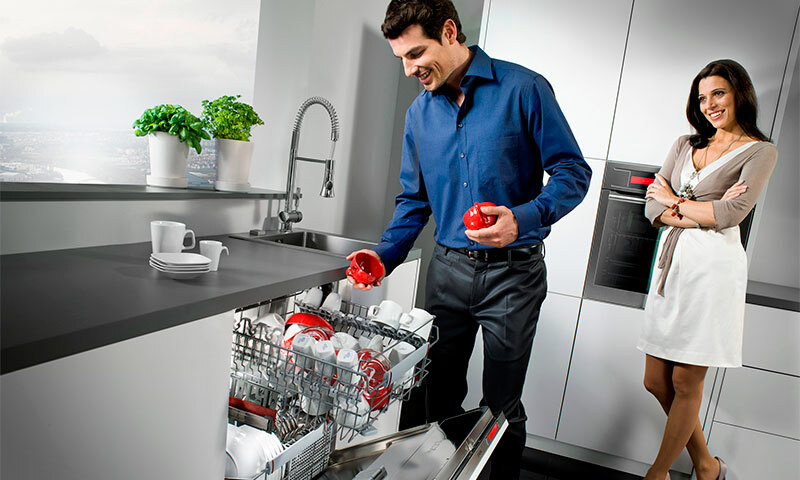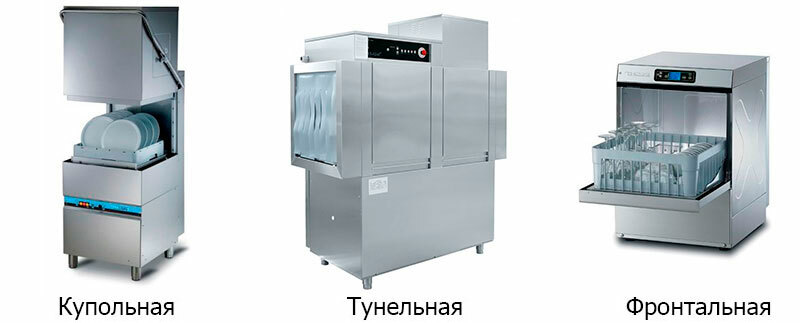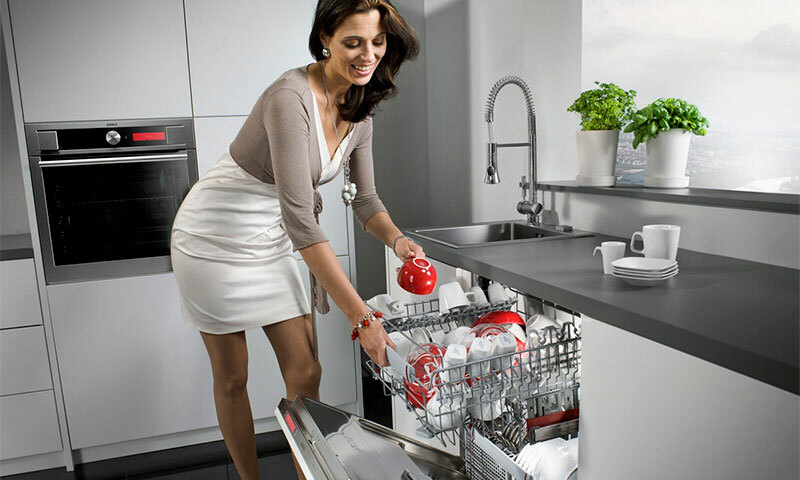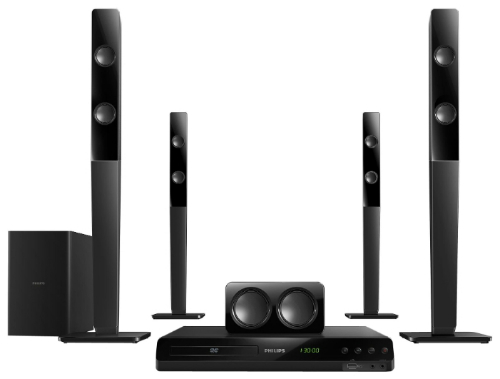Have you finally decided to buy a dishwasher or just want to find out what kind of new-fashioned unit it is and will it help you with your housework? We will tell you not only how to choose a dishwasher, but also reveal many options and nuances for buying such a device, its device, features and capabilities.

Contents:
- Should you buy the machine dishwashing
- Overall Dimensions and work
- Types dishwashers - what are they
- Design features and design
- Additional features
- How to choose
- Ranking of the best manufacturers of dishwashers - top 12
- Best Dishwashingmachines with a width of 45 cm
- Purchase price
- Video: how to choose a dishwasher
Is it worth buying a dishwashing machine
Transferring the washing-up processinto the hands "of machines we are much slower than abroad - the majority of our fellow citizens still prefer to wash the mountain of dishes and pans hands. However, those who at least once tried them in action are unlikely to answer "no" to the question whether a dishwasher needs a busy housewife in a large family( and even more so in public places).
Purpose
Similar devices can wash almost any objects of kitchen utensils, regardless of the condition of their contamination - plates and glasses, pots and pans, cutlery and various cook tools. Material dishes which can be washed in the machine may also be different:
- glass,
- porcelain,
- enameled metal,
- iron,
- products with non-stick coating,
- plastic.
Washing the car is not recommended for products made from hygroscopic, bystrookislyaemyh, nezharostoykih easily measurable chemical and mechanical resistance of materials - wood, bone, brass, copper, tin, silver and mother of pearl. In particular, aluminum dishes in the dishwasher are oxidized and there may be holes in it.
+ Advantages of
We are used to washing dishes with our hands, without thinking that it takes a lot of time and effort, especially after eating a family of 3, 4 or more people. In contrast to the manual method daily providing ware purity engine embodiment has a mass of indisputable advantages:
- Ability qualitative washing the maximum hot water and even with presoaking, which allows not only to eliminate any visible contamination, but also eliminate invisible bacteria,
- Self cleaning surfaceswithout the use of scratching brushes and sponges,
- Freeing the hostess time, which she will be able to spend on more necessary activities and rest,
- Fast simultaneous weTHIEY a large number of dishes - up to 17 sets,
- Excluding the negative impact of water, detergents and mechanical damage to the skin of hands and nails,
- Automatic drying products without the appearance of them smudges and stains,
- lack of "debris" of dirty dishes in the sink andon the kitchen table, even if there is no time to wash it on time.
It is checked that during machine washing the process takes much less water than with a manual method - the water consumption in the dishwasher is about 3 times less, which is significant if there are metering devices in the apartment.
-
Deficiencies With all the benefits of washing machines have a number of drawbacks that come from the most automated ideas - they work on electricity and set in advance a program that can not be changed in the course of action.
Therefore, when buying and operating it should be remembered that:
- Energy is spent both on the work itself and on heating the water.
- Before loading into the machine, all items must be cleaned of large food residues.
- The machine will require special detergents, which must be prepared in advance, as they are not always in the nearest store.
- One dishwasher cycle will take longer than the same work by hand. If clean appliances are urgently needed, it will be inadvisable to use the machine.
If every time you have to wash a huge amount of dishes - in large families or even a cafe, the minuses of the dishwasher become irrelevant, and the pluses - are predominant and significant.
General device and principle of operation
The variety of dishwashing units that is available in the modern market is determined by the needs of users - the number of dishes available, the installation possibilities, the functional requirements, etc. Let's try to figure this out, beginning with a common for all machines device and ending with their original features.
Regardless of the difference in design and additional options, the overall set of units and the operating principle of the dishwasher are standard for any of them. This includes:
- An infusion system that triggers clean water inside the unit, consisting of a hose, an intake valve and a coarse filter.
- Tan for heating cold water, in some cases flowing - built into the main pump.
- The device for pressure feeding of liquid on the dishes - the pump and rotating rockers through which the directed jets come out.
- Drain pump and hose for discharge of waste water.
- Compartments for the necessary chemicals - washing, rinsing and controlling the hardness of water.
- Baskets and trays for different types of dishes.
Work begins with the pouring of water and( if necessary) its heating. Then the pump starts to pump it through the rocker arms. They begin to rotate under the action of jet thrust, spraying hot liquid in different directions. When the soaking mode is activated, the dishes moistened with water are left so for a while, after which the main process of washing begins. Dirty water goes into the drainage, and the machine rinses the kitchen accessories with clean water and dries them.
Types of dishwashers - what they are
"Dishwashers" can be industrial and household types, which basically differ in size and performance. Production samples can be with dome, frontal or tunnel type of loading - dome type and tunnel dishwashers are designed for large catering enterprises, and frontal ones are more convenient for bars.

Industrial dishwashers
Household dishwashers
"Home" dishwasher types are classified according to the following parameters:
Fit:
- full-size: have a standard width of 60 cm, calculated on the number of dishes up to 12-14 sets,
- narrow machineswidth 45 or 40 cm simultaneously wash up to 8-10 sets,
- compact dishwashers of desktop type have small sizes both in depth and in height, containing no more than 7 sets of dishes.

Household dishwashers
By the installation method:
- partially built-in units become an integral part of the kitchen furniture, standing out only from the control panel.
- fully equipped dishwashers do not interfere with the overall interior line, as they are completely "hidden" in furniture - under the countertop or sink, and the dashboard is located on top of the door.
- non-adjustable or detached dishwashers after installation look like a separate household appliance.

How to install the dishwasher
You can buy a dishwasher for the purpose of using it even without running water - for cottages or in areas with problematic water supply. It happens both automatic and manual - you just need to pour clean water and activate the mechanism. Moreover, the country option can be offered with a ready set of plates and cutlery.
In addition, there are combined versions of washing machines, originally built-in or combined with other equipment - for example, a gas cooker or an oven with a dishwasher. In this case, you do not have to look for a separate place for the dishwasher, and the "2 in 1" device will cost less than if you buy each unit separately.
Design and design features of the

All components of the machine are selected taking into account the ease of use and obtaining the highest cleaning results. At the same time, some distinctive elements of individual components and components can be significant for performing various tasks:
1. The baskets for placing dishes are supplemented with:
- holders and special cells for cups, small plates, cutlery, which contributes to their safety,
- the possibility of adjusting the height of the mount, depending on the size of the items being loaded.
2. The type of drying of kitchen utensils in the machine can be different. The question of which drying is better in the dishwasher is solved from the needs of saving time and money:
- Condensation is more common, with it the moisture evaporates from the plates and pans naturally, due to their high temperature. Then drops of water settle on the cold walls of the washing chamber and are removed by a common drain. This method takes more time and can leave small spots, but is considered the most economical.
- Turbo dryer - used less often, passes by blowing a warm airflow from the fan. Reduces the time of one cycle, but increases the power consumption and cost of the machine when buying.
3. Both the water supply and its drainage is equipped with a filter to prevent foreign matter from entering the tank or pump of the dishwasher. To ensure that the output filter is not clogged with dirt, it is recommended to remove all food residues from the plates.
IMPORTANT!The inner surfaces of the dishwasher are often made of stainless steel. This ensures hygienic operation and extends the life of the machine.
Additional features of the
The device can be equipped with various additional options that expand its functionality, as well as making machines more convenient and safe. They include:
- Reinforced sound insulation, which reduces the noise level of the dishwasher to 47 - 57 decibels.
- Crusher for waste and automatic cleaning machines, allowing not to particularly zealous in the preliminary cleaning of dishes and care of the machine.
- The choice of washing programs - on average for different modifications from 4 to 8( and for universal machines - up to 12), which can be used soaking, additional washing, raising or lowering the temperature, economy mode, etc..
- The water level sensor( Aqua-Control, Waterproof, etc.), which controls the operation of the pressure switch - in cases of overfilling, the camera turns on an emergency drain and even beeps.
- The electronic display will show the user which washing stage is being performed at a specific time and how long it will take.
- Convenient little things like "child protection"( door lock), delay start, etc.
How to choose the right

Before discussing any model, it is necessary to study in detail the features of different types - what sizes are dishwashers, how they are installed, how much they consume energy and what their performance is. All parameters can be divided into 2 groups: according to the general design and technical capabilities of the machine.
1. On the design of
Kitchen interior features and the amount of dirty dishes will prompt which one to choose - embedded or desktop, full-size or compact:
- Full size 60 cm wide - built-in or stand-alone - suitable for installation in a spacious room, and its purchase will be the most convenient option for a large family, whose members usually eat at home.
- Narrow width of 45 cm or less( the width of the narrowest - 35 cm) will be the best choice in a small-sized kitchen for a family of 2 - 3 people or for more frequent use.
- Compact desktop, the dimensions of which are comparable to a microwave( the smallest can measure 45x55x45), suitable for a small family if it is impossible to install it on the floor or on a temporary place of residence( rented apartments, etc.).It should be remembered that it will not be possible to wash too large dishes.
- A stand-alone device is bought by those who do not have the kitchen furniture for embedding additional equipment into it, and it is not expected to change it in the near future.
- Completely built-in machine will be the best option for those who are going to start repairing the kitchen or buying new furniture. It harmoniously fits into a small space and will not stand out from the general interior line.
The dimensions of the built-in appliances must match the capabilities of your kitchen furniture, so you should buy them together or make exact measurements before purchasing. Here it is best to invite a specialist - and to measure the required dimensions, and the installation must be done at a professional level.
2. According to the technical parameters of
The most "actual" technical indicator of any electrical household appliance is the power consumed by it. For dishwashers it is denoted by Latin letters from A to G - only seven classes. The height of the class indicates the energy efficiency of the device. So, the first three give the following values:
- "A" - from 0.8 to 1.05 kWh per cycle,
- "B" - from 1.06 to 1.09 kWh per cycle,
- "C" - from 1,1 to 1.49 kWh per cycle.
Classes F and G indicate non-economical models( most often in obsolete samples).
No less important for the dishwasher amount of water consumed by it. On average, this parameter is in the range of 14 to 16 liters per complete cycle at a temperature of 600.
And lastly, the temperature capabilities. They expand for more expensive products, but in general 3 most applicable modes are used:
- Intensive - when water is heated up to 750,
- Savory - up to 300 or 400,
- Fast rinsing without heating up.
Rating of the best manufacturers of dishwashers - top 12
Choosing which dishwasher is best for you, you have to face a huge variety of models and firms offering them. Machines with similar parameters of popular manufacturers often turn out to be much better, and unexpected repairs are easier and cheaper.

It's hard to say which dishwasher is the best company, without getting acquainted with the products of companies exhibiting their models on the market. Regular monitoring of the quality of models of different manufacturers compare them by the criteria of reliability in operation, wear resistance, ease of use, a set of functions, price and user feedback. In the list of the top 12, worthy of maintaining a balance between price and quality, there were such world manufacturers as
1. Bosh
2. Siemens
3. Veko
4. Kandy
5. Hotpoint Ariston
6. Hans
7. Whirlpool
8. Zanussi
9. Samsung
10. Miele
11. Ikea
12. Lg
Among them strong leadership still keeps Bosh - a German brand of industrial and householdtechnology of very high quality, supplying products to all markets of the world, fromIt complies with the complete set of requirements for dishwasher units and provides the widest range of all types and types.
The best built-in dishwasher with a width of 45 cm

Rating of the best dishwashers of the most popular type( narrow in width 45 cm) at the moment looks as follows:
- Bosch SPV 53M10 - fully tuned low noise( 46 dB), used for various dishes and cutlery, offers several automatic programs,, door lock and delay start function.
- Bosch SPV 40E10 size 45x57x82 cm - partially integrated with a noise level of 52 dB, power class A, gives 4 programs at 3 different temperature modes, a full set of protective functions, washing up to 9 sets,
- Hotpoint-Ariston LSF 723 withdimensions 45x60x85 cm - stand alone with a noise level of 49 dB, takes up to 10 sets of dishes, performs 7 washing programs.
- BEKO DIS 5831, 44.8 × 54.8 × 82 cm in size, is fully integrated, washes up to 10 sets and is very economical in terms of wastewater consumption( up to 9 liters), gives 8 programs at 7 temperature conditions.
- Miele G4700 SCi - built-in, 44.8x57x80.5 cm, with a noise level of 46 dB, with a capacity of up to 9 sets and full protection against leaks.
Each of them is good in its own way - where more functionality, which is more economical, what is more reliable protection from unforeseen situations. The choice depends on the needs of a particular buyer.
Cost of purchase
The answer to the question of how much a dishwasher is worth depends on the chosen brand, design and capabilities of the machine. Of course, prestigious brands have a slightly higher price, but you get additional guarantees of excellent uninterrupted operation and high reliability of the device. Compact models cost less than all, and narrow models are cheaper than full-size ones by about 10-15%.
According to the price and quality of the dishwashing machine, it can be divided into the following groups:
- The cheapest( economy class) will cost about $ 300 - 400,
- Functional class of good capacity when performing the required set of options - at $ 450 - 550,
- Machinescomfort-class with additional functions - about $ 600 - 750,
- Elite-class models with high load, full protection and various options - above $ 800.
In each of them, prices vary depending on the size, number of operations and design.
Video: how to choose a dishwasher
Buying a dishwasher is a significant relief for the family to provide regular, full-value meals in perfectly clean dishes. As you can see, this case should be approached thoroughly, having previously estimated its capabilities and needs. Knowing common features combined with studying the characteristics of specific models will help to make the right choice, and a new dishwasher will delight you with the ideal work every day and for many years.


